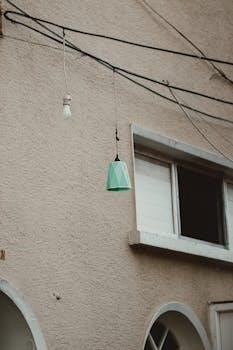
emergency lighting wiring guide
Emergency lighting wiring is a crucial aspect of building safety, ensuring illumination during power failures․ This system relies on specific electrical connections and components, including batteries and inverters․ Understanding these wiring diagrams is essential for proper installation․ These systems ensure safe evacuation routes during emergencies, offering critical backup lighting․
Importance of Emergency Lighting Systems
Emergency lighting systems are paramount for ensuring the safety of building occupants during power outages or other emergency situations․ These systems provide crucial illumination, facilitating safe evacuation and preventing panic in critical moments․ Without properly functioning emergency lighting, individuals may struggle to navigate through darkened spaces, leading to accidents and injuries․ These systems are not merely a convenience; they are a fundamental safety measure mandated by building codes and regulations․ The reliability of these systems depends heavily on correct wiring and component functionality, underscoring the need for meticulous installation and maintenance․ Emergency lighting ensures pathways and exits remain visible, enabling orderly and efficient evacuation procedures․ Moreover, they help first responders navigate buildings safely during emergencies, further enhancing overall safety and security․ Well-designed emergency lighting contributes to a sense of calm during high-stress situations, making it a vital part of any comprehensive safety plan․ Therefore, investing in and maintaining a reliable emergency lighting system is essential for the protection of lives and property․

Understanding Emergency Lighting Components
Emergency lighting systems consist of several key parts, including batteries, inverters, and luminaires․ These components work together to provide backup illumination during power failures․ Understanding each part is crucial for proper wiring and system functionality․
Self-Contained vs․ Central Battery Systems
Emergency lighting systems are broadly categorized into self-contained and central battery types, each with distinct characteristics and wiring requirements․ Self-contained systems incorporate batteries, inverters, and luminaires within each individual unit․ These are typically simpler to install, as they only require connection to the mains power supply and offer flexibility in placement․ They are ideal for smaller buildings or areas where a central system isn’t feasible․ In contrast, central battery systems use a single, large battery bank to power multiple emergency lights․ This approach offers greater control and monitoring, often used in larger commercial or industrial buildings․ Central systems necessitate more complex wiring schemes, including dedicated circuits to each emergency luminaire from the central battery․ The choice between these two depends on factors like building size, maintenance requirements, and budget constraints․ Central systems can offer longer backup durations and reduced maintenance, though the initial cost can be higher․ Self-contained systems provide a simpler, more localized solution, suitable for many applications․
Key Components⁚ Batteries, Inverters, and Luminaires
Emergency lighting systems rely on three core components⁚ batteries, inverters, and luminaires․ Batteries serve as the backup power source, providing energy when the main power fails․ These are typically rechargeable and must be appropriately sized for the required backup duration․ Inverters convert the DC power from the batteries to AC power, which is necessary to operate the luminaires․ They ensure a stable power supply during emergencies and manage battery charging during normal operation․ Luminaires are the actual light fixtures, often LED-based due to their energy efficiency and longevity․ They are designed to provide adequate illumination for safe egress during power outages․ Proper wiring of these components is critical for a reliable emergency lighting system․ The connections must be secure and comply with safety standards․ Incorrect connections can lead to system failure, compromising the safety of building occupants․ Each component plays a vital role in ensuring that emergency lighting functions effectively when needed․

Emergency Lighting Wiring Diagrams
Emergency lighting wiring diagrams are visual representations of electrical connections․ These diagrams show how components like batteries, inverters, and luminaires are interconnected․ They are essential for correct and reliable installation of emergency lighting systems․
Basic Wiring Diagram Overview
A basic wiring diagram for emergency lighting provides a schematic representation of the electrical connections within the system․ It illustrates how the power source, typically a mains supply and a backup battery, is connected to the emergency light fixtures․ These diagrams use standard symbols to denote components such as switches, inverters, and the luminaires themselves․ The overview includes the path of both the normal power and emergency power circuits․ Understanding this basic layout is crucial to ensure that the lights function correctly during a power outage․ In a typical diagram, you will see a connection to the main power supply, a connection to the battery backup system, and the wiring that feeds the actual emergency lights․ It also shows the placement of the test switch that allows manual testing of the emergency system․ This diagram serves as the foundation for more complex wiring scenarios, and thus understanding its fundamentals is essential for proper wiring and maintenance of the whole system․ The primary goal of this overview is to provide a clear picture of how each component interacts within the emergency lighting system․
Maintained vs․ Non-Maintained System Wiring
The distinction between maintained and non-maintained emergency lighting systems is crucial and affects their wiring configurations․ Maintained systems, designed to be continuously lit, have a different wiring setup compared to non-maintained systems․ In a maintained system, the emergency lights are powered from the mains supply during normal operation and automatically switch to battery power if there’s a power failure․ This requires a circuit that can provide both normal and emergency power․ Non-maintained systems, on the other hand, are normally off and only activate during a power cut․ Their wiring is simpler as they only use the mains power for charging the battery․ The main difference in the wiring lies in the switch-over mechanism and how the power is delivered to the lights․ Maintained systems often require a more complex setup with additional relays or switching devices․ It is very important to understand the differences in wiring for each type, to ensure optimal operation; The correct wiring ensures both systems perform their designed function during normal operation and power failure․

Step-by-Step Wiring Guide
This section provides a detailed, step-by-step approach to installing emergency light wiring, ensuring a reliable and effective system․ Following these steps correctly is critical for proper functionality․ This guide covers mounting, connections, and testing․
Mounting the Emergency Light Fixture
Begin by carefully selecting the appropriate location for your emergency light fixture, ensuring it is positioned to effectively illuminate escape routes and critical areas․ Securely mount the fixture using the appropriate hardware, whether it is a surface mount, recessed, or suspended installation․ Always consult the manufacturer’s instructions for specific mounting guidelines․ Ensure the mounting surface is stable and can support the weight of the fixture․ Consider the viewing angles and optimal light distribution when deciding on the final placement․ Double-check that the fixture is level and firmly attached to prevent any accidental dislodgement․ Use a level to verify the fixture is straight and flush with the mounting surface․ Proper mounting is essential for the safety and effectiveness of the emergency lighting system․ This step ensures the lights are ready to provide reliable illumination when needed during emergencies, contributing to a safer environment․ Remember to take all necessary safety precautions during mounting․
Connecting Power Supply and Backup Battery
After securely mounting the fixture, the next crucial step involves connecting the power supply․ Carefully link the emergency light to the main power source, following the wiring diagram provided by the manufacturer․ Ensure all connections are tight and secure, preventing loose wires․ For 120V supply, connect the line wire to the black lead, and for 277V supply, connect to the orange lead, while the neutral wire should be connected to the white lead․ Cap any unused wires with wire nuts or approved insulators to prevent unsafe conditions․ Next, wire the backup battery to the designated terminals, ensuring proper polarity․ This connection enables the light to operate during power outages, providing necessary illumination․ Double-check all connections before proceeding, ensuring the backup battery is correctly connected․ Follow the specific instructions for your emergency light model to prevent damage or malfunction; These proper connections are essential for the system to work effectively․
Testing and Verification
After completing the wiring, thorough testing and verification are essential to ensure the emergency lighting system functions correctly․ Initially, restore the main power supply and verify that the emergency light operates in normal mode․ Next, simulate a power outage by disconnecting the main power source․ The emergency light should automatically switch to battery backup and illuminate․ Observe the light output to confirm it provides adequate illumination for safe evacuation․ Check that the indicator lights, if present, are functioning as expected, often showing the system status․ If the light does not operate correctly, review the wiring connections and battery status․ Perform regular testing, as recommended by the manufacturer, to maintain system reliability․ Some systems might have test switches for easier verification․ Ensure all components are working before finalizing the installation, and document the test results for future reference․ If there are any issues, address them before assuming everything is working as expected․

Advanced Wiring Concepts
Advanced emergency lighting wiring involves integrating dimmer systems and utilizing test switches for more sophisticated control․ These concepts enhance functionality, allowing for more adaptable and easily verifiable emergency lighting․ It ensures optimal performance during regular and emergency situations․
Wiring with Dimmer Systems
Integrating emergency lighting with dimmer systems requires careful consideration to ensure both normal and emergency functionality․ During normal operation, these lights can be dimmed using 0-10V dimmers or panels, offering energy-saving and ambiance control․ A switched wire allows for on/off control of both regular and emergency lights, providing flexibility in everyday use․ However, in the event of a power outage, the emergency lighting must automatically switch to full brightness․ This is often achieved through a connection that bypasses the dimmer․ The ELCD-FD, for instance, opens the 0-10V connection during an emergency, bringing lights to their full potential․ This ensures that emergency lighting is always at its brightest during critical situations․ Wiring must therefore accommodate both the dimming circuit and the direct power needed for emergency mode․ This ensures optimal visibility during power failures, while also allowing energy-efficient everyday dimming, making it a complex, yet crucial part of the overall lighting design․
Utilizing Test Switches
Test switches are integral components of emergency lighting systems, allowing for routine checks of functionality without causing an actual power outage․ These switches enable users to simulate a power failure, verifying that the emergency lights activate correctly and that the backup batteries are working as expected․ Typically, a test switch temporarily disconnects the normal power supply, forcing the emergency lights to draw power from their battery backup․ The switch allows for easy maintenance and troubleshooting, ensuring the emergency system is always ready for a real emergency․ Some advanced setups use a neon indicator to signal when the lights are in test mode, providing clear feedback to maintenance personnel․ This indicator helps distinguish between normal and test states, simplifying the testing process․ The use of test switches is essential for meeting safety standards and ensuring the continuous reliability of the entire emergency lighting infrastructure․ They are a simple yet vital tool for keeping occupants safe․


Leave a Reply
You must be logged in to post a comment.